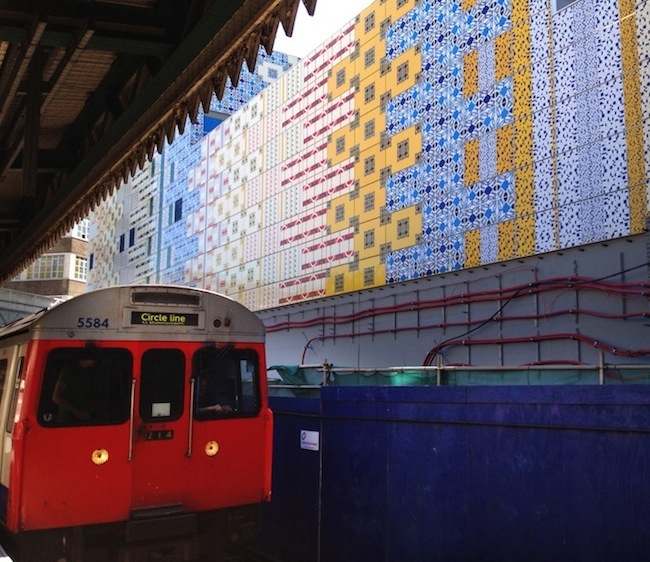This post should be listed under CFile’s “Not Clay But…” heading, as the work is actually of enameled metal, which is a close cousin to ceramics because it is also fired (albeit at low temperature). Kinship or not, we were compelled to share this work by one of the most significant Postmodernist pioneers, Jacqueline Poncelet, who worked in ceramics during the late 20th century before moving on to other media.
Wrapper is a permanent artwork, made especially to clad the new building and perimeter wall next to Edgware Road (Circle line) tube station in London. The work dresses the building in a grid of patterns developed by the artist, according to the Transport For London description of the project. Each pattern relates to a different part of the local area and was made in response to the images and ideas that Poncelet developed through her research there over the past three years. Like an enormous patchwork, Wrapper tells the story of the place in which it sits, weaving together elements from local history and the natural environment, the area’s architecture, and its people.
Set in the urban environment of central London, Wrapper joins a diverse landscape of buildings, with a mixture of scales, functions, and architectural designs. It stands out as a bright and colorful object whilst simultaneously blending in as a new addition to an area already full of constructions of all kinds and ages, from office blocks and houses to shops and schools. A work on this scale could have dominated the area, but Poncelet’s mix of patterns brings a kind of fragmentation to the building that helps to integrate it with its neighbors. In the busy environment of the Edgware Road area, the design also reflects the way in which the building will be viewed: more often in parts than as a whole.
Depending on where the viewer stands in relation to the artwork, Wrapper reveals a variety of stories. From the platform, for example, the fringe of the station’s roof can be recognized in the zig-zag pattern integrated into the work. On the other side of the building, local residents who can view it from their windows, or the people who pass by on foot, will see many more elements from the local area: the detailed tracings of leaves reference the trees in Regents Park, while the delicate water pattern suggests the Tyburn stream that runs underground nearby. Seen from a distance or as a fleeting glimpse from a vehicle on Marylebone Road, Poncelet’s patterns, some of which she made from a drawing of cars, will look quite different again. The colors all reflect those of the Tube map, hinting at the building’s connection to it.
Patterns and colors play a key role as storytellers in Wrapper and in Poncelet’s other work. She uses them in carefully considered configurations and each has a very particular place and purpose in the overall composition. Through this visual choreography, the artist aims to generate illusionary spaces or simply to modulate stillness and movement. “A pattern not only speaks of other places, but of changes in our culture and the passage of time,” says Poncelet. With the patterns devised for Wrapper, she has replicated how we choose what we see in a complex and busy environment. By condensing her experience of the area and her understanding of the site through these motifs, she highlights the pleasures, large and small, that a place can awaken in us. This is the largest work created by Poncelet to date; indeed, it is the largest vitreous enamel artwork in Europe.
Garth Clark is the Chief Editor of CFile.
Above image: Jacqueline Poncelet, Wrapper, 2012. Enameled metal on building. Courtesy of the artist.








Jacqueline Poncelet, Wrapper, 2012. Enameled metal on building. All images courtesy of the artist.
Watch a video of Poncelet conducting a tour of her project
Visit Art on the Underground via Transport for London

Beautiful work and a rare piece of urban art/architecture that sits in an interesting way in its environment. It has the feel of both a beautiful contemporary pattern and a kind of urban camoflage which breaks up the scale of the piece in interesting visual ways.
Thanks, Tom! There’s certainly plenty here to keep people’s eyes busy while they wait for the train.